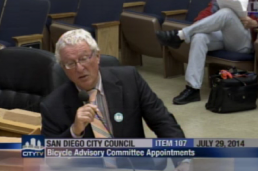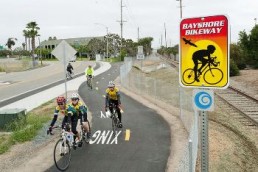San Diego City Council Adopts City's First Bicycle Advisory Committee
Earlier this week, on Tuesday, San Diego's City Council unanimously approved the creation of the city's first Bicycle Advisory Committee. This was a goal that was originally proposed in the 2002 city adopted bike plan, the city's second plan to accommodate bicycling.

Getting this committee established was one of our goals for our second year of existence (we launched as an organization in 2012). The composition of the committee calls for each Councilmember adopting one appointee and the two appointees made by the Mayor. Districts 4, 6, and 7 do not have a representative yet, so if you live in these neighborhoods now would be a nice time to get to know your elected representatives at City Council.
The current members of this new advisory committee include the following:
- Petr Krysl, involved with bicycling planning in UCSD where he is also a professor, representing District 1
- Nicole Burgess, who has been asking for improvements on Nimitz for as long as this website has been in existence, representing District 2
- Michael Brennan, the founder of San Diego Streets for People and a board member and a voice of reason at the Uptown Parking District representing District 3
- Kathleen Keehan, former executive director of the San Diego County Bicycle Coalition from 1999 to 2011, representing District 5
- Randy Van Vleck, Active Transportation Manager at the City Heights Community Development Corporation, representing District 9
- Andrew Hanshaw, current executive director of the San Diego County Bicycle Coalition and founder of Bike the Bay, representing District 3
- Kyle Heiskala, who led a successful student fee referendum at UCSD for bus and light rail access representing District 3
- and myself, Samantha Ollinger, representing District 8.
If you're not sure what all the District numbers mean, here is a link to a neat map that visually shows the entire city and its council districts.
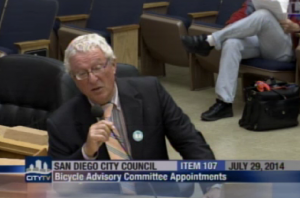
At the Council session on Tuesday, the item to approve the committee was scheduled to be on the consent agenda (essentially voted on without any discussion), however frequent Council Chambers visitor and occasional mayoral candidate, Steven Greenwald, asked for the item to taken out of consent and open for discussion. He was the only member of the public who spoke about the item and he spoke in support of it. He voiced support for "designated bike lanes" and asked that the city look to Vancouver for inspiration. He also talked up bike trains, which Nicole Burgess has been leading in Ocean Beach, and Veronica and Sandra have been leading in Mid-City. Greenwald also mentioned that not all drivers were "sensitive to the fact that bicycles have a place in transportation".
All councilmembers provided positive comments.
Marti Emerald (District 9) stated that perhaps even she could one day be on a bicycle, but that she was "petrified" to ride in traffic today.
Mark Kersey (District 5) thanked Kathy Keehan for her willingness to serve.
Sherri Lightner (District 1) thanked Petr Krysl for his willingness to serve.
Lorie Zapf (District 6 and soon to be District 2) thanked the entire group of committee members and recalled her experience of riding with Burgess and spoke about the needed changes to accommodate the upcoming bike share program as well and changes at Nimitz Boulevard and where the I-8 meets the dog park.
David Alvarez (District 8) spoke about the Climate Action Plan and commended the current District 2 staff that ride to their jobs at City Hall.
Ed Harris (interim Councilmember in District 2) seemed a bit surprised that the issue of bicycling had made a dent at City Hall and made generally positive comments as well.
Scott Sherman (District 7) spoke about the positive effects of seeing more people on bicycles.
Todd Gloria (District 3) stated that this was simply a formalization of the work that all of us had done to date. He also mentioned that the work done in the city to date were "modest" but wanted to see work sped up. Gloria also mentioned that the bike share program was scheduled to launch on October 30th this year. Gloria emphasized that this committee would be working with city staff to advise them on the work that needed to be done.
Emerald made a motion to approve the creation of the Bicycle Advisory Committee and newly re-elected Councilmember of District 2 (to be seated in November) Lorie Zapf seconded the motion.
New Buffered Bike Lanes on Fourth and Fifth Avenue
The City of San Diego completed its first road diet on Tuesday. The new buffered bike lanes run from Elm Street to Laurel along Fourth and Fifth Avenue in Bankers Hill.
City's #PublicWorks Dept create a #bike friendly lane on 4th and 5th Ave in Bankers Hill. Advancing mobility options! pic.twitter.com/AIpmfIRSAN
— Anthony Bernal (@AnthonyBernalSD) May 7, 2014
People were riding on them even before the paint was dry on the road.
City of San Diego completed its first road diet on 4th and 5th Ave. today. Great timing for bike month! @ToddGloria pic.twitter.com/YtxAFHGgVR
— Adrian Granda (@GrandaAdrian) May 6, 2014
Yeah, City of SD 1st road diet. This is the 1st stage of the Downtown Bike Loop. Get ready SD, here come the bikes!! pic.twitter.com/4vOwfQ8oye
— Linda Marabian (@Linda92101) May 7, 2014
New 4th Street buffered bike lanes. Just in time for #biketoworkday pic.twitter.com/pNTVZK61xZ
— Joe Punsalan (@joepunsalan) May 7, 2014
This is #SDFuture! Multi-modal roads making it safe for all modes of transportation! pic.twitter.com/yWtQHGOMIM
— Il Papa Bernasconi (@bernasconi) May 7, 2014
The buffered bike lanes were implemented in preparation of the upcoming bike share program. This project was originally scheduled to be completed earlier this year in January, the city's Transportation staff tried to coordinate with SANDAG in how the project would be implemented to better prepare for the Uptown Early Action Project's eventual implementation and hit some snags. Thankfully, those snags didn't delay the implementation for too long.
Much thanks to the city's Department of Transportation and Deputy Director Linda Marabian and Councilmember Todd Gloria and his team. Don't be shy about sending your thanks to them.
Update: Bankers Hill Residents Group gives a thumbs up to the new bike lanes. The ladies behind Hillquest, meanwhile, remain doubtful by all the enthusiasm and positive focus.
Foto Friday: Bike Parking Infrastructure in Balboa Park
This morning #iMayor Todd Gloria dedicated the first of 20 bike corrals scheduled to be installed throughout Balboa Park. In his comments he noted,
...in my state of the city address two weeks ago, I laid out a transportation vision for our future that really is about making bicycling more of a viable option for folks [who are] getting from A to B. And this is a step in actually fulfilling that vision and making it a reality. I think that Bruce [Shank] and Ken and others who ride here in the park everyday know that many people like to ride their bikes through the park. But they don't necessarily stop because we don't have the infrastructure. Well that ends today. This is the first of 20 installations that we will have throughout the park so that bicyclists know they can come and safely store their bikes and go out and enjoy some of the best cultural offerings in the world right here in Balboa Park. [More] importantly it will encourage people to actually leave their [car] keys at home and hopefully ride their bikes to the park. We have a real [vehicle] parking challenge in this park. This is one of the ways to address that. It's very cost effective, its environmentally sensitive. And it's the direction we ought to be going as a city.
...
...this is part of a broader effort[...]. It's not just about [you getting] here, but getting here safely, comfortably and then we don't just get the spandex enthusiasts, but you get the Todd Glorias of the world who want to bike but who don't always feel comfortable doing that. And again, they can take that conveyance as taxpayers and enjoy what they are paying for: the most magnificent park in the country.

Funds for the new bike racks were provided by the San Diego Foundation. The Foundation's President and CEO, Bob Kelly, stated,
We are honored to be able to provide funding to increase access to Balboa Park while preserving the historic character of the Park. This project aligns perfectly with The San Diego Foundation’s Opening the Outdoors initiative which seeks to provide park and outdoor access to all San Diegans,
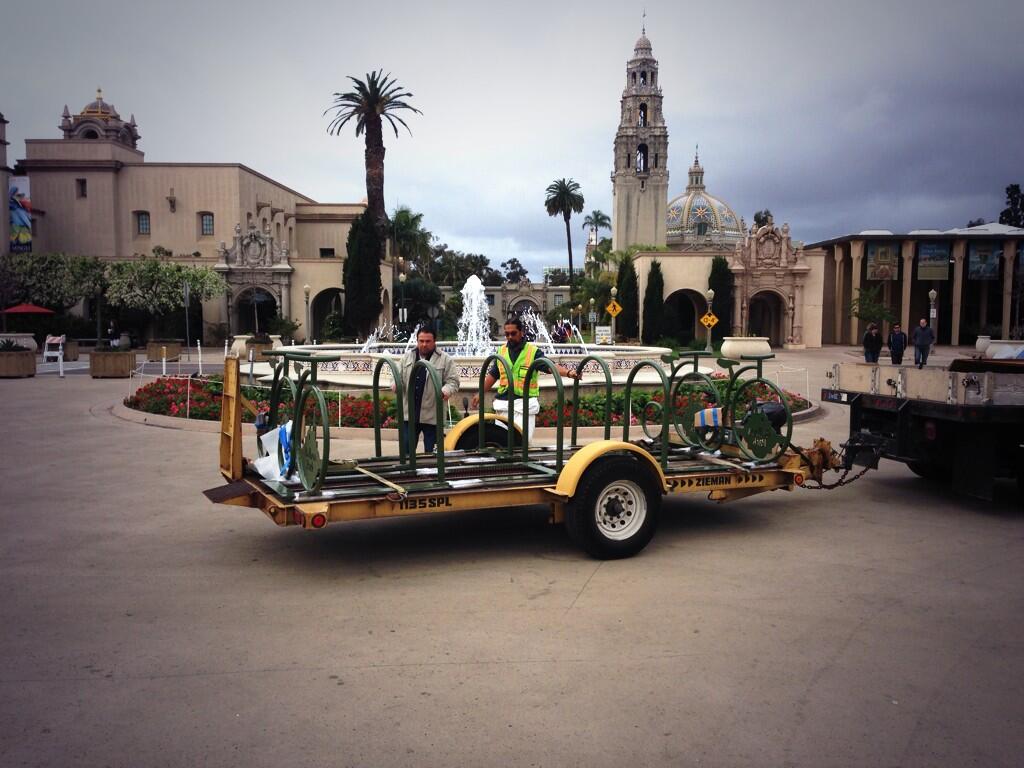

These new bike racks are indeed a fine new addition to Balboa Park. Check them out and if you snap a photo and post it to your preferred social media outlet, don't forget to tag #bikeSD.
Height Restrictions and Bicycles: Uptown is at a Transportation Crossroads
What is the Interim Height Ordinance, and what does it have to do with bicycles?
Currently, the Interim Height Ordinance (IHO) limits building heights in Hillcrest and Mission Hills to 65 and 50 feet, respectively. Prior to the IHO, the 1998 Uptown Community Plan allowed building heights up to 200 feet on some streets, and under these guidelines a 12-story hotel was proposed for 301 University Avenue in 2008. The project was out of scale for the relatively narrow street, so residents protested, and the City Council enacted the IHO for the two years required to complete Uptown’s Community Plan.
That was then. Now, over five years later, the Community Plan is targeted for completion in late 2015. Meanwhile the IHO has been extended repeatedly. Many residents and community leaders advocate for making it permanent, or even further reducing its height limit.
Why should Bike SD’s readers care about Uptown building heights? Because the Uptown Planners (the community planning group for Hillcrest, Bankers Hill, Mission Hills and University Heights) advises the city on both this issue and the proposed SANDAG Uptown Bike Corridor. Many of the board and community members who oppose smart growth in Uptown also oppose implementing safe bike lanes. Last year, Uptown Planners voted against even considering bike corridor implementation in their neighborhoods until the community plan was completed. In my next post, I’ll discuss the bike corridor in greater detail, and whether increased density can make neighborhoods more bike-friendly.
Since the IHO went into effect, the trend of millennials and empty-nesters moving to urban neighborhoods from suburbs has increased. Good resources on the subject include recent books The End of the Suburbs, Walkable City, and The Great Inversion and the Future of the American City. These new residents seek walkable, bikeable, active communities with various transit options to nearby downtown jobs. “Smart growth” and “transit-oriented development” are two terms describing the mixed-use construction built to accommodate them. There are numerous benefits to this trend, from reduced vehicle miles driven to increased public transit use, even increased innovation and reduced obesity rates. In San Diego, with projections of a large population increase in Council District 3, Hillcrest represents an ideal location for smart growth - without putting all new growth downtown, as some suggest.
Instead of addressing this demand, the IHO has arguably suppressed residential construction in Hillcrest. IHO supporters cited the Snooze AM building on 5th Avenue as an example of IHO-era construction, but it contains zero residential units. While there are many excellent examples of urban neighborhoods with human-scale architectures of 5 stories, commercial thoroughfares like eastern University Avenue, Park Boulevard, and 4th/5th/6th Avenues all present opportunities to carefully exceed this height without ruining the neighborhood’s character. To be fair, construction costs do increase significantly above 65 feet, and raising the height limit won’t magically produce affordable and middle class housing - but it would likely offer an improvement over the current lack of construction.
What are some reasonable alternatives to making the IHO permanent that permit mixed-use projects on main streets while retaining neighborhood character? One plan floated by city planning staff set 45-65 foot height limits for Mission Hills and Hillcrest, with discretionary review required above that level. Heights could surpass 100 feet if community amenities were provided, such as parks or plazas. Another plan offered by Walt Chambers on his Great Streets San Diego site considers commercial street widths. At a recent Uptown Planners meeting where Chambers’ plan was presented, the Uptown Community Planning Group Chair, Leo Wilson, acknowledged that height/discretionary limits between 65 and 100 feet might be a workable compromise.
Unfortunately, many community members are unwilling to budge from the IHO. Chief among their complaints are: congestion and lack of parking. However these problems are present in almost any urban neighborhood around the country.
Nearly all of San Diego was built for cars, often at the expense of pedestrians and bicycle riders. However I think Hillcrest is great precisely because it is different in this regard. The Hillcrest community owes its strengths of being more walkable with diverse amenities largely to its higher density (relative to the rest of the city). Furthermore, many potential new residents to Uptown have little desire to own a car and seek alternative transit options. So why do Uptown's leaders continue to insist on applying suburban planning principles to their community?
A diversity of incomes in Uptown could reduce congestion, since some lower-income workers would live near their jobs rather than driving in and parking. Instead, Hillcrest’s anti-growth stance is morphing it into a neighborhood that is exclusive only to individuals who occupy a higher income bracket. This is troubling, since the Uptown neighborhood used to welcome anyone - especially gays and lesbians who experienced discrimination. Now many of these same community members who used to be discriminated against are unwittingly discriminating against middle and lower-income earners, as they close the door to new residents due to their shortsighted stance on height limits and downzoning.
IHO proponents frequently state that the “good businesses will survive” without new growth, but doesn’t this aversion to increasing the height limit limit the total number of good businesses? Instead of a virtuous urban cycle of more residents attracting more businesses attracting more residents that we’ve witnessed in North Park and Little Italy, Hillcrest’s businesses struggle and the neighborhood’s vibrancy wanes.
Some residents have described a fear that outside developers would tear down historic architecture, but as a member of Save our Heritage Organisation, I support strengthening the city’s historic preservation laws in order to prevent this.
Bicycle riders will benefit from awareness of the challenges they face in implementing bike infrastructure in Uptown. The majority of the Uptown Planners’ board members, and the residents who attend its meetings, have demonstrated that they are either woefully out of touch or simply opposed to the interests of tomorrow’s Uptown residents. It’s important that we all participate in planning Uptown’s future, whether the issue is building heights or cycle tracks.
---
You can read more from Paul Jamason at SD Urban
$312 million updated Bike Plan passes with unanimous support from City Council

Last Monday, the update to the 2002 Bicycle Master Plan passed with unanimous support from the City Council. This plan to build an additional 595 miles of bicycle facilities nearly doubles the city's existing 510 miles* of facilities and further demonstrated our council's growing commitment to bicycling.
During public comment, two of our proposed requests were included in the motion made by Council Member (and current mayoral candidate) David Alvarez and amended by Council Member Sherri Lightner. Our request to create a Bicycle Advisory Committee to ensure the implementation of the plan was also supported by the San Diego County Bicycle Coalition (SDCBC). Our request to remove the Coastal Rail Trail alignments from Rose and Roselle Canyons was not supported by the SDCBC but was supported by the community that this alignment affected: the Friends of Rose Canyon, the University Community Planning Group and Council Member Lightner whose district includes University City. Council Member Lightner spoke to not only preserving the city's limited remaining open space but to also saving the city the huge financial and environmental expenses of building in Rose and Roselle Canyons - an amendment that was accepted by Alvarez and the rest of the council.

Melissa Garcia, Senior Planner at the City of San Diego, presented the item for council consideration by stating that the goal of the plan was to "create a city where bicycling is a choice." The goal to promote "environmental quality, public health and recreation and mobility benefits" were also mentioned. The purpose of the plan, Garcia stated, was to "maximize spending choices for implementation."
The original Bicycle Master Plan was adopted by the City Council over a decade ago in 2002. The update to the 2002 Bicycle Master Plan was prepared by Alta Planning + Design for the City of San Diego and begins with this promising statement in its introduction:
"...the updated plan provides direction for expanding the existing bikeway network, connecting gaps, addressing constrained areas, improving intersections, providing for greater local and regional connectivity, and encouraging more residents to bicycle more often."
Since 2002, most of the facilities built have been incredible and award-winning (such as the bike path around Lake Murray and Miramar Reservoir), but not effective in meeting the needs of everyday San Diegans by connecting neighborhoods to ensure daily riding in a way that is safe and comfortable. In the two years since the plan was updated, the plan went through respectable community feedback and input. Is the plan the best that it can be for current and future riders? The plan is incredibly promising and it should give everyone cause to celebrate. But a good plan alone will not transform our city. The important lesson from the last Monday's vote is that the political will is unanimous and the way forward is to ensure that this plan actually gets implemented with the efforts of a Bicycle Advisory Committee.

What will this committee do and who will it be composed of? That depends on what the City Attorney proposes to the City Council, but we'd like to have council staff, city staff, advocates and community members (including high school and college students) be active representatives. This committee will ensure that facilities get built and that the group doesn't become yet another layer of bureaucracy inhibiting the implementation of the bicycle plan. We'd like to see all facilities implemented with complete transparency.
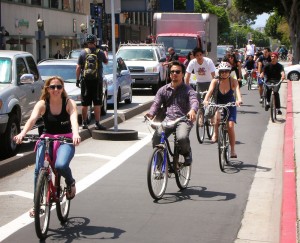
In this year alone, our council members have demonstrated incredible leadership. Interim Mayor Todd Gloria was the first to lead on the issue. Gloria has been very receptive to feedback, ideas, and has demonstrated a willingness to lead in a way that has not been seen before in San Diego. Council member and Land Use and Housing Chair Lorie Zapf's Council Resolution has provided us with much needed leverage to ensure accountability from the city staff in implementing bicycle infrastructure in the city. We have also learned how to listen to communities (such as the Friends of Rose Canyon) that seek us out and explain their concerns. Our success in transforming this city into a world-class city for bicycling depends on meeting the needs of our current ridership and being open and receptive to the feedback we receive from potential riders.
The next steps are not only to create the Bicycle Advisory Committee, but also to ensure that the plan is implemented. How will that happen? That will be the work for BikeSD's second year. Thank you for joining us on the ride.

---

